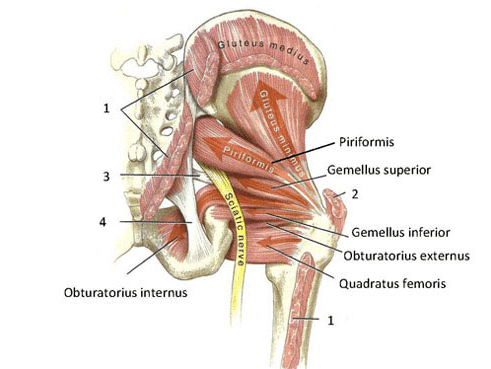Sports Injuries and Management
What Is Piriformis Syndrome?
The Piriformis Muscle And Piriformis Syndrome
Piriformis syndrome is considered a somewhat controversial condition among the medical fraternity. The condition can mimic sciatica with origin from the lumbar discs and as a result is sometimes also referred to as ‘pseudo sciatica’ or wallet sciatica. The piriformis muscle anatomically is a flat small muscle located deep in the buttock, lying under the cover of the gluteus maximus (which is the large gluteal muscle that gives the buttocks its round(ish) shape). With piriformis syndrome it is believed that this piriformis muscle irritates, or compresses the proximal sciatic nerve due to contracture and/or spasm of the piriformis causing neuritis (inflammation of the nerve). The result of this irritation to the sciatic nerve is that the individual may experience pain, numbness and/or tingling along path of the sciatic nerve running down the back of the leg and into the foot. Symptoms similar to that which is felt with true sciatic pain, hence the name pseudo sciatica and wallet sciatica.
Anatomy Of The Piriformis Muscle
The piriformis muscle originates mostly from the sacrum which is large bone at the base of the spine that makes up the back of the pelvis and connects be inserting to the upper surface of the femur (thigh bone). Specifically anatomically the piriformis runs from the front of the S2-S4 vertebrae to insert on the greater trochanter of the femur. The origin and insertion of muscles are important and where they come from and where the attach into dictates their action on the body. Due to these origins and insertions the piriformis function is to help in rotating the hip outwards, known as external rotation and abducting, which is the movement of the femur away from the body. Due to these origins and insertions the exact action piriformis creates on the hip joint is dependent on the position of the hip at the time of action, if the hip is flexed up towards the chest verses behind you as in late stance phase walking, the piriformis muscle will have slightly different actions. Through its roll as an abductor and rotator at the hip,the piriformis muscle can be considered to be a stabilizer of the hip joint.
Piriformis And The Sciatic Nerve
Classically the sciatic nerve runs vertically directly beneath piriformis as pictured above, however variations in the anatomy between individuals exist (as pictured below). It is estimated that in approximately 20% of people, the muscle belly of piriformis is split and one, or more parts of the sciatic nerve divide the muscle belly, rather than passing beneath as per the considered anatomical norm.
These anatomical variations between the sciatic nerve in the pelvis and piriformis muscle have been observed, but said variations are not necessarily related to individuals being symptomatic or not. Meaning some people diagnosed with piriformis syndrome have been shown to have the anatomically common path of the sciatic nerve (where it passes below the muscle) and conversely the presence of a piriformis muscle divided by the sciatic nerve is not a guarantee someone will experience symptoms of piriformis syndrome. The relationship between sciatica nerve course variations and symptoms not being perfectly entwined is one of the main reasons that piriformis syndrome is considered a controversial diagnosis of buttock pain and sciatica symptoms among practitioners.
Disclaimer: Sydney Physio Clinic provides this information as an educational service and is not intended to serve as medical advice. Anyone seeking specific advice or assistance on What Is Piriformis Syndrome? should consult his or her general practitioner, physiotherapist, sports medicine specialist, orthopedic surgeon or otherwise appropriately skilled practitioner.




